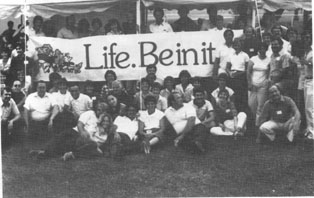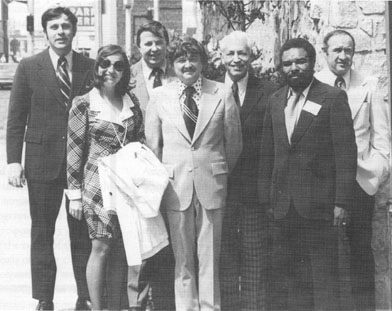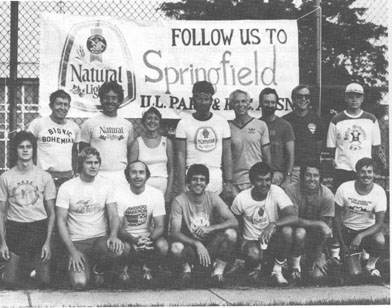SPECIAL FOCUS
History Can Be Fun
The ramblings of a researcher into IPRA's beginnings.
BY KAY FOREST, CAE
|
Researching the history of the Illinois Park and
Recreation Association (IPRA) was fun. It allowed
me to go back to the actual roots of the park and
recreation profession in Illinois. I found some
interesting information that may shed some light as
to why the profession is so strong in Illinois today. I
also discovered that it is difficult to determine how
old IPRA really is. (Age is a state of mind anyway.)
The first attempt to form a statewide recreation
association happened in 1935. A few meetings were
held, and then it died out in 1937 with the Works
Projects Administration (WPA), a work program
established by President Theodore Roosevelt that
built many of Illinois' first swimming pools. |
IPRA professionals pose for a group picture
at the association's first booth at the
Illinois State Fair:

|
The next information that I could find was for the
year 1944 when a conference of Illinois recreation
workers was held at the University of Illinois. Thirty-five people attended the first conference and most of
the education centered on postwar planning and
getting people trained in recreation. The attendees
must have had a great time since they decided that it
was time to organize an Illinois Recreation Association (IRA). Its main purposes were to continue the state conference, act as a clearinghouse for tax
problems (sound familiar), address legal issues, and
conduct postwar planning.
Russel Perry, director of recreation in Aurora, was
selected to develop the constitution for IRA. (Must
have been a good one because we are still here.) IRA's
1945 dues were $2.50 to $25, depending on the
population of the city. (I wonder how that relates to
current dollars.) In 1946, me dues structure was
changed to center on individuals, not departments,
Professionals paid $1 and cities were now only $5.
(Guess our forefathers thought $20 to $25 was too high
and that the individuals should pay their own way.)
Research was a high priority for early IRA
members. A few issues studied were salaries and car
allowances (Did they have cars back then?), youth
programming, recreational use of schools, and
legislation. What was important to our founders is
still important today.
42 / Illinois Parks and Recreation
The first newsletter was published in 1947 with
Howard Copp, superintendent of recreation in
wilmette as the editor. We affiliated with a national
organization, the American Recreation Society, in
1948, and members paid joint dues. (Seems like we
keep resurrecting old ideas.)
As we progress into the 1950s, the conference was
still the highlight of the year for the members (just
like the 1990s, huh), but they had branched into new
areas of concern: youth, day camps, and sports and
athletics for women. The original constitution was
revised in 1951. (A pattern was established because, if
you track it, IPRA's bylaws have been revised about
every five years since then.)
In the mid '50s, the state was divided into regions:
Metropolitan, North, Central and Southern. (So, this
is where the upstate vs. downstate began.) These
regions still exist today for IPRA. More formal
committees were established to deal with legislation,
publications, membership, girls/women's issues,
awards, and research. Certification had its beginning
in 1955 when the IRA commissioned Al Sapora and
Russel Foval to study the topic.
In 1958 two big events happened. The Hospital
Section was formed and reported 70 members, and
the IRA received an invitation from the Illinois
Association of Park Districts to hold a joint meeting
in 1960 in Joliet. (Guess it was successful since we are
still doing it today.) In 1959, the total IRA member-ship was 308. (I wonder what the members thought
about the dues back then.)
By the mid '60s, (just about the time I entered the
picture as a student member), the association had
major growing pains. In 1964 the word "parks" was
added to the name and we became the Illinois Park
and Recreation Society (IPRS). Dues increased to
$15 for administrators, $10 for supervisors, and $5
for recreation leaders. I, however, paid $ 1 as a
student member and still remember complaining
about it to my professor. A part-time executive
director was employed and the IPRS office was
located in Cicero, where it remained until 1970.
In 1965 the society's official publication was titled,
the Illinois Park and Recreation Quarterly. There were
30 standing committees. (And we think we have too
many now.) A joint conference with IAPD was held
in St. Louis in 1966, and what a great tradition that
Started. By the end of that decade, IPRS had income
of about $10,000, and a membership of 612.
Another hallmark year was 1969 with the establishment of the Illinois Therapeutic Recreation Branch.
In 1970, a joint committee of IPRS and IAPD
proposed a resolution to both boards that each
organization retain its separate identity, yet join
together for particular efforts, such as publication of
the Illinois Parks and Recreation magazine, and
sponsorship of a conference. This was the first of
many formal actions that are laced throughout the
history of both IPRA and IAPD. The executive
director of IPRS became the editor of the new joint
magazine, Illinois Parks and Recreation, the IPRS
office was moved to Springfield to be housed with
IAPD.
|
The '70s began with IPRS endorsing recommended salaries of $10,000 for directors of parks and
recreation, and $9,000 for supervisors with a degree
and experience. They also recommended four weeks
vacation after eight years of services. (Look at how far
we have come). As we moved through the 1970s the
picture becomes much clearer. Since January 1973,
Kay Kastel (yours truly before marriage) was hired as
the full-time executive secretary and editor of the
magazine. We had 1,300 members, a budget of
$27,000, and there was record attendance at the
joint annual conference held in Arlington Heights.
(My salary was about half the budget. I wish I could say
that now.) The IPRS office was moved to Des Plaincs
and shared space with NRPA The first joint
agreement between IPRS and IAPD was implemented in 1974. This was the first time that IPRA
received an equal share of the conference profit.
Issues at this time were certification based on
education, experience and involvement (isn't that
being discussed now?), a state job bulletin, and
legislative efforts in cooperation with IAPD. The
agency mailing got its start in 1974 when key
agencies were mailed the IPRS board minutes.
The highlight of the '70s happened in 1976 when
a group of the best minds in Illinois gathered in Joliet
for three days to plan for the future of IPRS.
Implementing their recommendations, we officially |
IPRS and IAPD leaders meet in the
mid-'70s to discuss joint issues.

|
September/October 1997/ 43
HISTORY OF SRAS
became the Illinois Park and Recreation Association
(or IPRA) complete with six special interest sections.
(We've only added one since then.) Professional
membership requirements were established, the
executive secretary's title was changed to director,
and one full-time secretary was added to the staff.
|
The 1980s were the years of growth: growth in
membership, growth in staff, and growth in service.
IPRA took on several major special events to increase
public awareness. This included a "Run to Springfield" to open the Illinois State Fair. IPRA was given
a booth at the fair in the conservation area which we
staffed with interns for three days. It was our job to
provide games for fairgoers. (We are still involved at
the fair in the '90s with the jointly sponsored Park
District Conservation Day.) Attendance at the joint
conference continued to increase and the only sites
large enough for this annual event were in the
Chicago metro area. Membership dues were looked
at several times during this decade.
The board felt that in order to keep pace with all the changes in the
profession, and provide increased services, that IPRA
needed a stable dues structure. Thus we implemented a dues structure based on salaries. The
thought was that as salaries in the profession
increased, so also would IPRA's revenue. |

|
By the beginning of the 1990s the membership of
IPRA had grown to 1,700, and the budget increased
tenfold. Over the years we had built a healthy reserve
fund so the board decided to invest for the future by
purchasing office space. We had moved from Des
Plaines to Palatine (several moves in this community),
and now it was time to own something of our own.
We purchased our Winfield office in 1991 and by
1996 the IPRA mortgage was paid off and the
Winfield office is truly ours. During the '90s IPRA
continues to prosper. The staff of six full-time and
three part-time employees currently service more
than 2,100 members. We have added services and
quality and strive for 100 percent customer satisfaction.
IPRA has become the top state park and recreation association for professionals in the country. (Of course, I'm biased.) It only happened because our
forefathers looked into the future and planned for it.
They would be proud of us now. I wonder if they
had as much fun looking forward as I did looking
back.
Did IPRA have its beginning in 1935, 1944, 1964
or 1976? Now you see why it's hard to answer the
question. How old is IPRA?
KAY FOREST, CAE
is the executive director of the Illinois Park and Recreation Association. Photo: IPRAs
1981learn travels to the Illinois State fair to promote parks and recreation.
44 / Illinois Parks and Recreation


